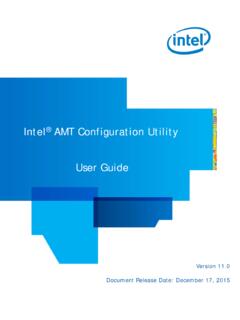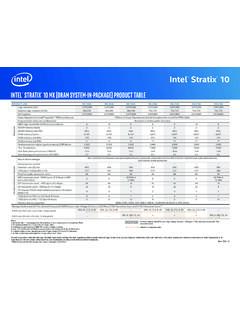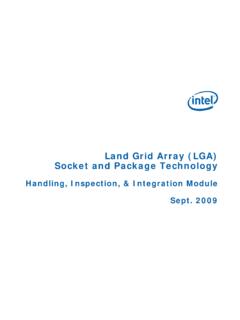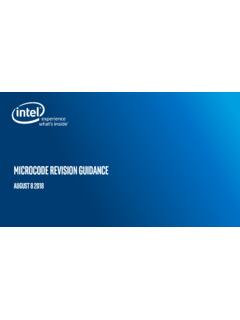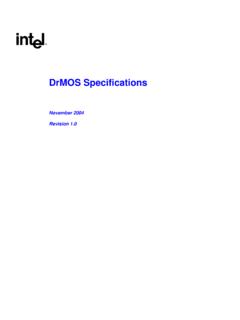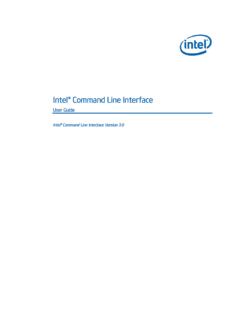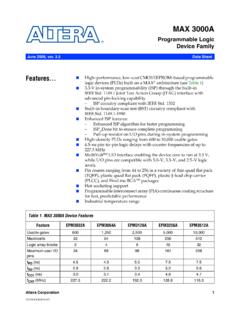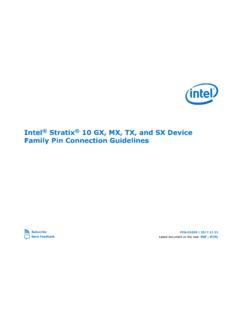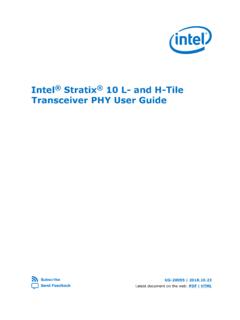Transcription of Serial Configuration (EPCS) Devices Datasheet - intel.com
1 April 2014 Altera 2014 Altera Corporation. All rights reserved. ALTERA, ARRIA, CYCLONE, HARDCOPY, MAX, MEGACORE, NIOS, QUARTUS and STRATIX words and logos are trademarks of Altera Corporation and registered in the Patent and Trademark Office and in other countries. All other words and logos identified as trademarks or service marks are the property of their respective holders as described at Altera warrants performance of its semiconductor products to current specifications in accordance with Altera's standard warranty, but reserves the right to make changes to any products and services at any time without notice. Altera assumes no responsibility or liability arising out of the application or use of any information, product, or service described herein except as expressly agreed to in writing by Altera.
2 Altera customers are advised to obtain the latest version of device specifications before relying on any published information and before placing orders for products or Innovation Drive San Jose, CA 95134 9001:2008 RegisteredSerial Configuration ( epcs ) Devices DatasheetThis Datasheet describes Serial Configuration ( epcs ) DevicesTa b l e 1 lists the supported Altera epcs le 1. Altera epcs DevicesDeviceMemory Size (bits)On-Chip Decompression SupportISP SupportCascading SupportReprogrammableRecommended Operating Voltage (V)EPCS11,048,576 NoYes NoYe ,194,304 NoYes NoYe ,777,216 NoYes NoYe ,108,864 NoYes NoYe ,217,728 NoYes NoYe more information about programming epcs Devices using the Altera Programming Unit (APU) or Master Programming Unit (MPU), refer to the Altera Programming Hardware epcs device can be re-programmed in system with ByteBlaster II download cable or an external microprocessor using SRunner.
3 For more information, refer to AN418: SRunner: An Embedded Solution for Serial Configuration Device Devices offer the following features: Supports active Serial (AS) x1 Configuration scheme Easy-to-use four-pin interface Low cost, low pin count, and non-volatile memory Low current during Configuration and near-zero standby mode current to operation EPCS1, EPCS4, and EPCS16 Devices available in 8-pin small-outline integrated circuit (SOIC) package EPCS64 and EPCS128 Devices available in 16-pin SOIC package Page 2 Functional DescriptionSerial Configuration ( epcs ) Devices DatasheetApril 2014 Altera Corporation Enables the Nios processor to access unused flash memory through AS memory interface Reprogrammable memory with more than 100,000 erase or program cycles Write protection support for memory sectors using status register bits In-system programming (ISP) support with SRunner software driver ISP support with USB-Blaster , EthernetBlaster, or ByteBlaster II download cables Additional programming support with the APU and programming hardware from BP Microsystems, System General, and other vendors By default, the memory array is erased and the bits are set to 1 Functional DescriptionTo configure a system using an SRAM-based device, each time you power on the device, you must load the Configuration data.
4 The epcs device is a flash memory device that can store Configuration data that you use for FPGA Configuration purpose after power on. You can use the epcs device on all FPGA that support AS x1 Configuration an 8-pin SOIC package, you can migrate vertically from the EPCS1 device to the EPCS4 or EPCS16 device. For a 16-pin SOIC package, you can migrate vertically from the EPCS64 device to the EPCS128 the new data decompression feature supported, you can determine using which epcs device to store the Configuration data for configuring your 1 shows how you can calculate the compression ratio to determine which epcs device is suitable for the 1. Compression Ratio CalculationEP4 SGX530 = 189,000,000 bitsEPCS128 = 134,217,728 bitsPreliminary data indicates that compression typically reduces the Configuration bitstream size by 35% to 55%.
5 Assume worst case that is 35% ,000,000 bits x = 122,850,000 bitsThe EPCS128 device is more information about the FPGA decompression feature, refer to the Configuration chapter in the appropriate device Serial FPGA ConfigurationPage 3 Serial Configuration ( epcs ) Devices DatasheetApril 2014 Altera CorporationFigure 1 shows the epcs device block 1. epcs Device Block DiagramControlLogicI/O ShiftRegisterMemoryArrayStatus RegisterAddress CounterDecode LogicData BuffernCSDCLKDATAASDIEPCS DeviceAccessing Memory in epcs DevicesYou can access the unused memory locations of the epcs device to store or retrieve data through the Nios processor and SOPC Builder. SOPC Builder is an Altera tool for creating bus-based (especially microprocessor-based) systems in Altera Devices . SOPC Builder assembles library components such as processors and memories into custom microprocessor Builder includes the epcs device controller core, which is an interface core designed specifically to work with the epcs device.
6 With this core, you can create a system with a Nios embedded processor that allows software access to any memory location within the epcs Serial FPGA ConfigurationThe following Altera FPGAs support the AS Configuration scheme with epcs Devices : Arria series Cyclone series All device families in the Stratix series except the Stratix device familyThere are four signals on the epcs device that interface directly with the FPGA s control signals. The epcs device signals are DATA, DCLK, ASDI, and nCS interface with the DATA0, DCLK, ASDO, and nCSO control signals on the FPGA, more information about the epcs device pin description, refer to Tab l e 23 on page 4 Active Serial FPGA ConfigurationSerial Configuration ( epcs ) Devices DatasheetApril 2014 Altera CorporationFigure 2 shows the Configuration of an FPGA device in the AS Configuration scheme with an epcs device using a download 2.
7 Altera FPGA Configuration in AS Mode Using a Download Cable (1), (4)DATADCLKnCSASDIDATA0 DCLKnCSOnCEnCONFIGnSTATUSMSEL[]nCEOCONF_ DONEASDOVCC (1)VCC (1)VCC (1)VCC (1)10 k 10 k 10 k 10 k (3)Altera FPGAEPCS Device (2) Pin to Figure 2:(1) For more information about the VCC value, refer to the Configuration chapter in the appropriate device handbook.(2) epcs Devices cannot be cascaded.(3) Connect the MSEL[] input pins to select the AS Configuration mode. For more information, refer to the Configuration chapter in the appropriate device handbook.(4) For more information about Configuration pin I/O requirements in an AS Configuration scheme for an Altera FPGA, refer to the Configuration chapter in the appropriate device Serial FPGA ConfigurationPage 5 Serial Configuration ( epcs ) Devices DatasheetApril 2014 Altera CorporationFigure 3 shows the Configuration of an FPGA device in the AS Configuration scheme with an epcs device using the APU or a third-party 3.
8 Altera FPGA Configuration in AS Mode Using APU or a Third-party Programmer (1), (4)DATADCLKnCSASDIDATA0 DCLKnCSOnCEnCONFIGnSTATUSMSEL[]nCEOCONF_ DONEASDOVCC (1)VCC (1)VCC (1)10 k 10 k 10 k (3)Altera FPGAEPCS Device (2) to Figure 3:(1) For more information about the VCC value, refer to the Configuration chapter in the appropriate device handbook.(2) epcs Devices cannot be cascaded.(3) Connect the MSEL[] input pins to select the AS Configuration mode. For more information, refer to the Configuration chapter in the appropriate device handbook.(4) For more information about Configuration pin I/O requirements in an AS Configuration scheme for an Altera FPGA, refer to the Configuration chapter in the appropriate device an AS Configuration , the FPGA acts as the Configuration master in the Configuration flow and provides the clock to the epcs device.
9 The FPGA enables the epcs device by pulling the nCS signal low using the nCSO signal as shown in Figure 2 and Figure 3. Then, the FPGA sends the instructions and addresses to the epcs device using the ASDO signal. The epcs device responds to the instructions by sending the Configuration data to the FPGA s DATA0 pin on the falling edge of DCLK. The data is latched into the FPGA on the next DCLK signal s falling the FPGA enters Configuration mode, ensure that VCC of the epcs device is ready. If VCC is not ready, you must hold nCONFIG low until all power rails of epcs device are FPGA controls the nSTATUS and CONF_DONE pins during Configuration in the AS mode. If the CONF_DONE signal does not go high at the end of Configuration , or if the signal goes high too early, the FPGA pulses its nSTATUS pin low to start a reconfiguration.
10 If the Configuration is successful, the FPGA releases the CONF_DONE pin, allowing the external 10-k resistor to pull the CONF_DONE signal high. The FPGA initialization begins after the CONF_DONE pin goes high. After the initialization, the FPGA enters user more information about configuring the FPGAs in AS Configuration mode or other Configuration modes, refer to the Configuration chapter in the appropriate device 6 Active Serial FPGA ConfigurationSerial Configuration ( epcs ) Devices DatasheetApril 2014 Altera CorporationYou can configure multiple Devices with a single epcs device. However, you cannot cascade epcs Devices . To ensure that the programming file size of the cascaded FPGAs does not exceed the capacity of an epcs device, refer to Ta b l e 1 on page 4 shows the AS Configuration scheme with multiple FPGAs in the chain.
